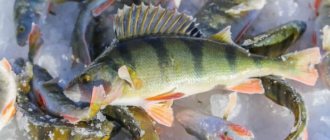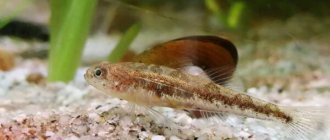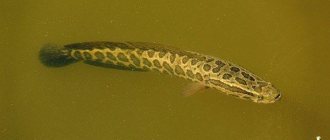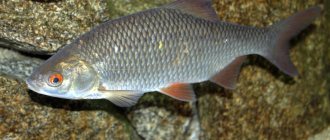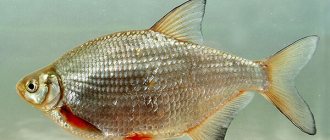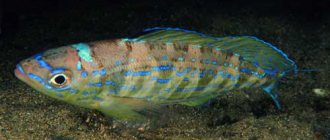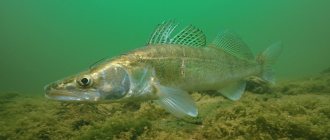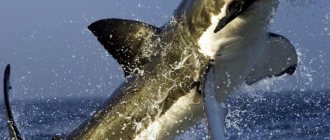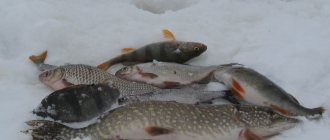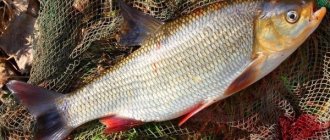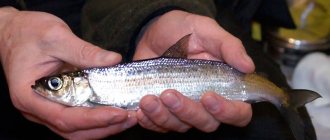- Wild animals
- >>
- Fish
The snakehead is not a dragon or a Gorynych snake, but an amazing and interesting predatory fish, which many are wary of, although it does not pose any threat to humans. On the contrary, many people believe that snakehead meat tastes simply amazing and has few bones. Let us characterize this unusual aquatic inhabitant from various angles, describing not only its extraordinary appearance, but also its fish habits, food preferences, nuances of the spawning period and places of permanent settlement.
Description and natural habitat
The predator's homeland was initially limited to the rivers and lakes of the Far East. In particular, it was observed in the basins of the Amur, Ussuri, and Razdolnaya rivers, as well as in lakes Khanka and Khasan.
In the second half of the 20th century, approximately 100 young individuals were brought to the Tashkent region, where the fish quickly multiplied and settled in the Syrdarya, from where they spread throughout all the reservoirs of Uzbekistan, Kazakhstan and Turkmenistan.
At the beginning of the 21st century, an aggressive predator suddenly appeared in the rivers of Maryland, California and Florida, which greatly frightened local residents. The US government gave permission for catching and created a ban on keeping and breeding it at home, explaining that local aquatic forms are not able to resist the Snakehead.
Snakehead photo gallery:
The appearance of the fish is unusual, the body has the shape of a cylinder and is slightly flattened from the sides only towards the tail. The large head is wide and compressed from top to bottom, vaguely similar to a snake. The skin is protected by scales with a smooth, rounded posterior edge. The organs of vision are small relative to the body, set close to the snout. The wide mouth is so large that its edges extend beyond the eyes. The back and anal fins are large and long, the caudal fin is rounded, and does not have a characteristic V-shaped notch.
The color of the Snakehead is dark, brown with chaotically scattered spots. From the gills to the eye, 2 dark stripes are clearly visible. Adult fish reach a meter or more in length and can weigh up to 30 kg.
A distinctive characteristic of the species is the ability to breathe using the epibranchial pouch. It was noted that when the water level in the rivers drops, the individual can survive on land for up to 5 days. The abundant secretion of mucus allows it to move along the ground or grass in search of another body of water.
Snakeheads prefer shallow areas of rivers with dense vegetation and attack prey from cover. They feed on their own kind, frogs, insects. They spawn in June-July.
Habitats
According to statistics, a significant part of snakeheads are found in fresh water bodies of Korea and Japan, and they are regularly brought into private fish farms, where they quickly reproduce, killing the fry. Representatives of the Amur species are characterized by the ability to quickly change their habitats in search of promising points with an abundance of food.
The biggest danger to the ichthyofauna are swamp specimens, which can grow to impressive sizes and kill everything that gets in their way. Most often they are found in the Primorsky Territory, located on the border with the People's Republic of China. It is known that this water area is home to more than 75 species of fish, which are in danger of extinction due to the life of the snakehead. Given this situation, biologists and local fisheries are beginning to make a lot of efforts to prevent the extinction of valuable inhabitants of a unique natural complex.
When choosing a place of residence, the snakehead prefers calm and quiet water, where there are many shelters, snags, sunken objects and other bottom obstacles. Reservoirs with an abundance of vegetation in the form of reeds and algae are a favorite water area for snakeheads.
At the same time, he is not afraid of the low concentration of oxygen, because in order to restore the necessary balance he only needs to swim to the surface for a few minutes. The resulting oxygen is retained for a long time in the epibranchial organs and air sacs.
Mr. Tail recommends: varieties
Snakeheads of various colors and sizes have been bred for aquarists. Let's look at the features of each type.
Golden Cobra
A beautiful fish, the color is predominantly gray with orange stripes interspersed with black dots, the same markings on the fins. Came from India, aggressive, kept alone. Reaches 60 cm in length.
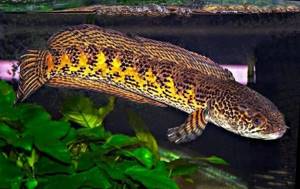
Requires special aquarium water parameters:
| Rigidity | Acidity | Temperature |
| 10° dH | 6.0-7.0 pH | +20…+26 °С |
Red-banded giant
In captivity it grows up to a meter and requires a large tank. Usually take a container of at least 400 liters. The pet is so aggressive that it attacks everything. Those whom he cannot swallow are simply torn to pieces. It is distinguished by the largest fangs of all snakehead species. Juveniles are attractively colored with bright orange stripes interspersed with solid black.
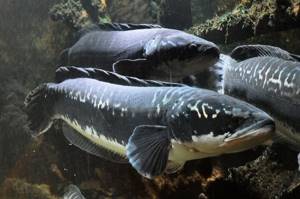
As they grow older, they turn pale and gradually become dark blue. They are thermophilic, require an ambient temperature of +26…+28 °C.
Dangerous for breeders, recommended for those who are absolutely sure of their choice.
Dwarf (gaucha)
Gray body with faint dark stripes, blue fins, red dot under the eyes. One of the most popular morphs. The homeland of the fish is India, several subspecies are known, slightly different from each other. The pet is peaceful, compatible with other underwater inhabitants of equal size. Adults reach 20 cm in length.
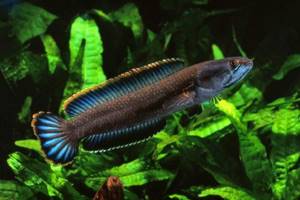
Loves cool water with the following characteristics:
| Rigidity | Acidity | Temperature |
| 6-8° dH | 6.0-7.5 pH | +18…+25 °С |
Imperial
The belly is light, the back is brown with black equally spaced diamonds. Reaches 65 cm in length and requires a large tank. Can only be combined with equally large pets. Conditions of detention are similar to the Golden Cobra.
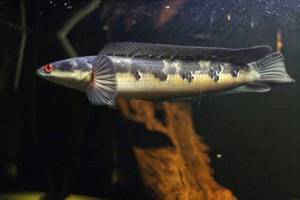
Rainbow
Brown with blue and orange splashes. The brightest of the varieties reaches 20 cm in length. Quite compatible with other pets, relatively friendly. Conditions of detention are similar to those of Karlikov.
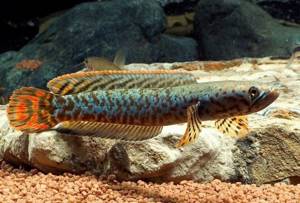
Bankanesis
The back is brown, the belly is white. There are small black spots all over the body. Despite its small size, no more than 23 cm, it is extremely aggressive.
It is not recommended to combine with other fish.
It is also demanding on the chemical parameters of water; the acidity level should not exceed 6.0. If the indicator is impaired, the pet becomes prone to various diseases.
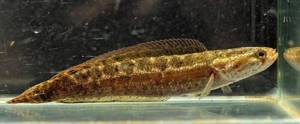
Lucius
Sandy-golden with black chaotic spots, quite large and requires a large tank. Adults grow up to 40 cm and are aggressive, so mixing with large neighbors is only permissible, but for personal peace of mind it is better to keep them alone. Temperature up to +28 °C.
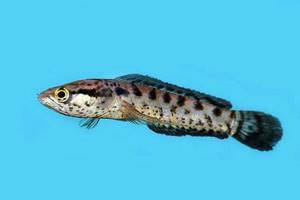
Three-point (speckled)
On the gray body there are large black spots outlined in gold (there is a resemblance to the eye), the same point is on the caudal fin. Large and strong, reaching 45 cm in length. The throwing speed is so high that it allows the Snakehead to catch any prey. It welcomes water with low acidity, but also feels good in neutral water.
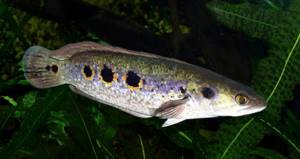
Spotted
Grayish-brown upperparts and light belly; dark patches are randomly scattered along the body, forming unfinished transverse stripes. Absolutely indifferent to the quality and temperature of water, aggressive, kept alone. Can grow up to 30 cm.
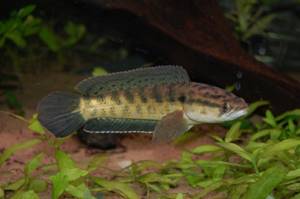
Chevron
The back is sandy brown, the belly is silver. Unpretentious appearance, indifferent to living conditions. Grows up to 90 cm, requires a large tank.
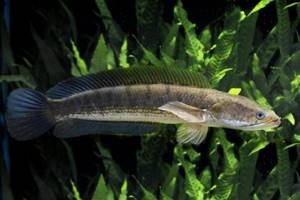
African
Spotted, with dark streaks on the light gray body. It differs from its counterparts in having elongated tubular nostrils. It grows up to 40 cm, and in terms of the chemical composition of the liquid is similar to Lucius.
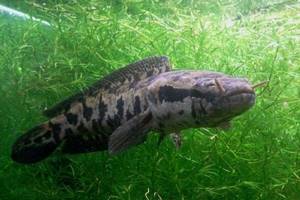
Stewart
A beautiful gray-blue fish of small size, up to 25 cm. Shy, spends most of its time in shelter. She will not touch her neighbors unless they break into her house or take away her food.
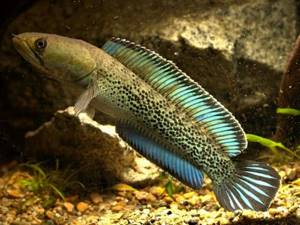
Pulchera
The blue-blue body is decorated with orange and black peas, the pectoral fins with black and white stripes effectively complement the image, the belly is slightly lighter than the main tone. Up to 35 cm in size, non-aggressive, omnivorous. They don't hide. There are 2 large fangs on the lower jaw, move with caution, they bite.
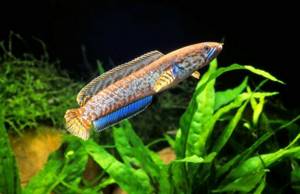
Hunting for snake fish - what you need to know and what gear you will need for successful fishing
Catching a snakehead is more reminiscent of hunting than fishing, because the predator is distinguished not only by its ferocious disposition, but also by its cunning. It is recommended to go for the desired trophy by boat; a motor is not needed here. It should be taken into account that a strong predator will desperately resist, so you cannot do without a strong two-handed fishing rod.
You shouldn’t count on catching a snakehead - you’ll have to force it through the grass, regardless of all technical techniques, so a powerful reel that can easily withstand a heavy load won’t hurt. Instead of a fishing line, a strong cord will do; a leash is not needed - it will only get tangled in the grass, complicating the already difficult process of catching a snakehead.
Snakehead fishing has many features, and the main thing here is not to make a mistake with the bait. The ideal option is a rubber frog, but you can try to catch a handsome one with a small dead fish.
It’s better to try all kinds of wiring options, because the predator’s capriciousness is legendary - he may refuse to take the bait, even if it moves from right to left, and not vice versa. The easiest way is to pull the frog so that it bounces slightly.
Snakeheads can take bait in any way:
- Throws himself at the bait.
- Jams with powerful tail strikes.
- Throws him into the air, grabbing him after falling into the water.
- Plays with easy prey, bites and plucks the frog.
It is impossible to guess the actions of a predator, so hooking is done intuitively, in the hope that maybe you will get lucky. Even if you managed to hook a snakehead, it’s too early to celebrate - the powerful fish resists so strongly that often only parts of the gear that are useless for anything remain.
What does fishing for snakehead entail? Torn cords, bent hooks, broken reels and a rod in pieces - you can suffer considerable losses. But what does tackle mean if you manage to pull out a huge trophy specimen that barely fits not only in a bag, but also in a boat? The pleasure of such fishing is difficult to describe, which is why many fishermen go hunting for the coveted prey, and even failure and broken gear do not become an obstacle - thrill-seekers do not lose hope and again return to the reservoir with the main inhabitant - the snakehead.
fishelovka.com
Hello everybody! Today we have come to probably the most interesting part of the story about the snakehead: HOW TO CATCH A SNAKEHEAD
A little about the tackle. The main weapon is, of course, a spinning rod with a test weight of up to 30-40, this is perfectly suitable for 3-4 kilogram fish, a medium-strength reel, or better yet a multiplier, a braided cord with a diameter of at least 0.24 and a bait. The most common type of bait is a silicone frog. Leashes and fishing line are not advisable. Everything is vomiting. The frog is attached to the cord directly through a bait-sized loop. It is not advisable to use carabiners. The first jerk of the snakehead is so deadly that you risk being left without bait. In my small practice this happened too. The model, color and size of the bait should be chosen based on the preferences of the snake. The color should be similar to the amphibians living in the reservoir. They can be seen on the shore. The most successful combinations will be black or brown back, white belly, swamp green and yellow-green work well in June, black and yellow in August. However, there are exceptions. At the end of the summer, when the reservoir is very overgrown with vegetation and the predator is about to lie down on the bottom, bright colors shoot out. And yet this is not a dogma. There are always some vagaries. Casting and Retrieving Catching a snakehead does not require any rush. As already mentioned, the predator is clearly visible on the surface of the water, so you will have time to put the boat in a convenient place. It is advisable to cast the bait onto the grass or shore, then with a gentle jerk throw the frog onto the water and wait a few seconds, then start retrieving. If, after a splash, the snakehead dives under the surface, do not rush to get upset, it is heading towards your frog. This is where you need to speed up the wiring a little. Most spinners perform this moment without a proper pause and it turns out that the uguru is aiming for a splash, and the frog is already far from this place. The wiring itself is performed with small jerky pulls. It is advisable to lead the bait all the way to the boat; the snake may sit nearby under the grass and not see you. If an arrow appears behind the frog, this is a sure sign that you are doing everything right. Then a loud blow, hold for a couple of seconds and hook! Strong hook!!! Further on the situation. If the snake does not sit down and the frog surfaces, continue the retrieve slowly, perhaps the snake decided to stun it. Be sure to remain quiet, especially if you are fishing at a short distance. When the snakeheads don't bite! 1. It is very difficult for a predator in deep water, for example, after heavy rainfall. The snakehead clings to the shore and sits between hummocks far from open water and it is not possible to place the bait. 2. During the spawning period, the snakehead is busy protecting its offspring and sends most baits away with a blow of its tail. During this period, the catfish may be activated. 3. The season ends at the end of August - beginning of September. Of course, if the vegetation allows, you can continue fishing with wobblers.
forum25medvedey.ru
Aquarium Basics
Snakeheads are large and aggressive, so in artificial reservoirs they are kept alone or with pets that can fight back, and there are very few of them.
The length of the tank should be equal to 2 adult individuals, and the width to one. Experienced experts believe that the optimal volume is up to 100 liters per small-sized couple.
The requirements for the chemical indicators of water are different for each type, as discussed above. As for the cleanliness of the environment, a filter is required; predators litter a lot. Replacements are made several times a week in small portions, up to 1/10 of the part.
Given the possibility of movement on land, the aquarium must be tightly closed. It is also worth remembering that the pet needs air to breathe, so leave a layer of at least 10 cm between the lid and the surface of the water.
The lighting should not be bright; in nature, they like to hide in dark pools, in thickets of vegetation, under snags and in grottoes. It is recommended to create similar conditions in the container.
It is better to use rocky, coarse soil. Plant algae in pots.
Lords of the reservoirs
Snakeheads have no enemies in their habitat. Even when moving to a new place of residence, they can cope with any predator that inhabits the pond. These fish are not a trivial threat to other inhabitants of water bodies. But exterminating and getting rid of them can be quite difficult, given their rapid reproduction, omnivorousness and extreme vitality. Therefore, in America, for example, the authorities do their best to prevent their appearance in the lakes and rivers of the country. It is forbidden to release them not only into water bodies, but even into sewers and toilets.
They call snakeheads "Frankenfish" and prohibit the transport of these fish from state to state and abroad. In our country, they tried to use the snakehead as a medic, to exterminate trash fish from reservoirs where their valuable species were grown. But they soon realized what a threat loomed over all living things living in these reservoirs. Moreover, getting rid of the snakehead itself is much more difficult. It is worth thinking seriously and weighing all the pros and cons before deciding to resettle and breed this “beast” in our reservoirs.
Also, read on the website:
Reproduction
Pets are ready to breed when they reach 2 years of age. By this moment they are already quite large and reach 35 cm. Spawning takes place in the summer at a water temperature of +18...+20 °C.
First, the male builds a large nest from plants, up to a meter in diameter. In it, the female lays eggs, which have their own fat particles that help float to the surface and remain in the upper layers until the fry appears. During the season, a sexually mature individual is capable of sweeping up to 30,000 babies. The larvae hatch 5 days after spawning.
Parents carefully protect the nest and the area around it. The mother carefully fans her offspring with her fins, creating a slight current. After the young hatch, the parents do not abandon them, but continue to jealously protect them. This is why fish reproduce so quickly.
Human use
People use snakeheads for food; large specimens weighing over 20 kg have a lot of tasty, nutritious and fatty meat. The fishing process is also entertaining and more like hunting. A special rubber frog is used as bait.
The bite starts in the afternoon and lasts until late in the evening. Fishermen on rubber boats move along or against the flow of the river. Sometimes the predator is not in the mood and may not take the bait just because of the wrong direction.
When biting, behavior can also be different. Sometimes the fish plays around with the bait, sometimes grabbing it and then letting it go. It is worth considering that the power of the predator is great, so it is better to hold the fishing rod while standing.
What does a snakehead eat?
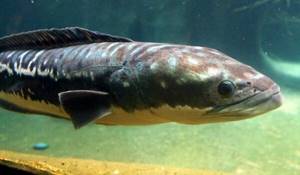
Photo: Snakehead in Russia
The snakehead can rightfully be called an insatiable aquatic inhabitant; in its gluttony it is similar to the rotan. The predator is unpretentious in food, sweeping away literally everything that gets in its way. It is not for nothing that these fish are not favored in the USA, because most often it happens that the snakehead eats all the other fish in the body of water in which it has settled. The snakehead often hides in ambush, rushing to attack with lightning speed when it detects a victim; such deadly attacks can be repeated several times. Many tiny and sharp teeth do not leave potential prey any chance of salvation.
The snakehead eats with pleasure and great appetite:
- other fish, not being afraid to attack fish larger than himself;
- larvae of all kinds of insects;
- insects;
- frogs;
- mayfly
If a snakehead has such an opportunity, then during a river flood it will definitely feast on mice and bird chicks. The fish will not disdain its closest relatives, without a twinge of conscience devouring a smaller snakehead. Predators are most active from May to October; during this period the water warms up well. In August, fish gluttony simply goes off scale; it seems that snakeheads eat everything, without going overboard. This type of fish received the title of the most ferocious freshwater predator of Primorye, with an indomitable appetite.
Interesting fact: Because the snakehead loves to snack on frogs and loves swampy water, it is often called the frogfish.
Speaking about fishing, it is worth adding that snakeheads are caught using a bottom fishing rod (casting rod) using various baits.
Among which are:
- earthworms;
- frogs;
- small dead fish;
- meat of river shellfish.
Interesting Facts
The snakehead is a poorly studied species and is of interest to the scientific world. Some interesting facts are known today:
- Double breathing allows the fish to survive in the most unfavorable conditions. Having filled the gill sacs with air and buried itself almost a meter deep in the mud, it waits out a long drought.
- The predator's greed has played a cruel joke on him; food quickly runs out in the reservoirs of his habitat. To survive, evolution has endowed the fish with the ability to move from one backwater to another, and on land it can easily move for up to 5 days without diving.
- It is important for breeders to know that those species of Snakehead that are bright and beautiful at a young age turn into grayer and more inconspicuous in adulthood, and there are varieties with exactly the opposite properties.
Natural enemies of snakeheads

Photo: Snakehead in the river
In almost any body of water, the snakehead has no ill-wishers; this fish is not distinguished by delicacy and modesty, so it will rebuff any enemy. It is common for snakeheads to fiercely resist any neighbors that are unpleasant to them, surviving them in the literal sense of the word. Due to their aggressiveness and fertility, the ability to reproduce quickly, snakeheads occupy a dominant place in almost every body of water where they settle, destroying the entire ichthyofauna around them due to unprecedented gluttony and predation.
This merciless aggressor has a number of food competitors, it all depends on this or that type of reservoir. Thus, in large water areas, where there are no thickets and a large number of shallow waters, the pike wins the battle for food resources. In those places where deep and muddy pools predominate and there is a lot of coastal growth, the mustachioed and respectable catfish wins the battle for food. The snakehead is considered invincible in calm and shallow waters, the bottom of which is covered with snags and thickets.
Undoubtedly, one of the main enemies of the snakehead is the person who catches this fish because of its tasty meat, which contains almost no bones. A huge number of dishes can be prepared from snakehead; the fish is very nutritious and rich in various minerals and vitamins (phosphorus, calcium, amino acids). The main thing here is mastery of the culinary art and the secrets of preparing this unusual fish.
Interesting fact: Snakeheads are voracious, eat everything indiscriminately, love stagnant, swampy waters, so their meat can contain a large number of parasites; you need to be careful when gutting this fish and cooking it. Washing tools and hands after gutting a carcass is mandatory, and the cutting board is usually doused with boiling water.
